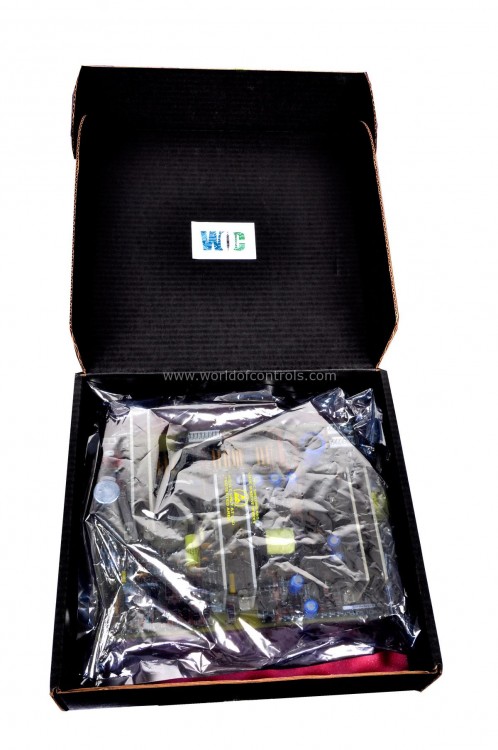
World Of Controls understands the criticality of your requirement and works towards reducing the lead time as much as possible.
DS3800NVOC - Voltage Controlled Oscillator Board is available in stock which ships the same day.
DS3800NVOC - Voltage Controlled Oscillator Board comes in UNUSED as well as REBUILT condition.
To avail our best deals for DS3800NVOC - Voltage Controlled Oscillator Board, contact us and we will get back to you within 24 hours.
SPECIFICATIONS:
Part No: DS3800NVOC
Manufacturer: General Electric
Series: Mark IV
Input Control Voltage: 0-10 V DC
Output Frequency Range: 1 kHz-100 kHz
Frequency Stability: ±0.01%
Phase Noise: -120 dBc/Hz
Output Amplitude: 0-5 V
Supply Voltage: 12–24 V DC
Board Type: Voltage Controlled Oscillator Board
Operating Temperature Range: -20°C to +70°C
Country of Origin: USA
Availability: In Stock
FUNCTIONAL DESCRIPTION:
DS3800NVOC is a Voltage Controlled Oscillator Board manufactured and designed by General Electric and is part of the Mark IV Series used in GE Speedtronic Gas Turbine Control Systems. The Board is designed to generate a stable oscillating signal whose frequency is directly controlled by an input voltage. The board converts a variable control voltage into a corresponding output frequency, allowing precise tuning of the signal for applications such as communication systems, signal modulation, and synchronization in electronic circuits. It supports various output waveforms, commonly sine, square, or triangular, depending on the circuit design, and incorporates features to maintain frequency stability, low phase noise, and reliable operation over a specified temperature and supply voltage range. The VCO Board is a critical component in systems requiring dynamic frequency adjustment, frequency synthesis, or timing control.
INSTALLATION:
The VOC Board should be mounted securely on a non-conductive or grounded surface to minimize mechanical stress and electromagnetic interference. Connect the control voltage input, power supply, and signal output terminals according to the board’s pin configuration, ensuring correct polarity and voltage levels. Proper grounding of the board is essential to maintain signal integrity and reduce noise. After connections are made, verify the output waveform and frequency response to ensure correct operation before integration into the larger system. The VOC Board must be installed carefully to ensure reliable operation and signal integrity. Key installation steps include:
OPERATION:
The VOC Board functions by translating a variable input control voltage into a precise output frequency, providing dynamic and accurate frequency control for electronic systems. The board’s output frequency is directly proportional to the applied voltage, enabling seamless frequency tuning across the designed range. This feature makes the VCO essential for applications such as communication systems, frequency synthesis, signal modulation, and synchronization in complex electronic circuits. Key points of operation include:
Control Voltage Application: The specified control voltage must be applied to the designated input terminal to modulate the oscillator frequency. The relationship between the voltage and frequency is typically linear, allowing predictable and repeatable tuning.
WOC maintains the largest inventory of OEM replacement parts for GE Speedtronic Control Systems, ensuring that you have access to genuine, high-quality components whenever needed. We specialize in providing unused, refurbished, and rebuilt boards, all of which come with a warranty for reliability and performance assurance. Whether you require parts for routine maintenance, system upgrades, or emergency replacements, our comprehensive stock ensures minimal downtime and uninterrupted operation of your control systems. We offer expert repair services for faulty boards, restoring them to full operational condition. Our team of skilled engineers and technicians is available 24/7, providing prompt support for any OEM requirements or automation challenges. For detailed information on part availability, repair services, or pricing, please reach out to our team directly via phone or email, and we will guide you with professional assistance tailored to your operational needs.
What is the primary function of a VOC Board?
The VOC Board generates an oscillating signal whose frequency is controlled by an input voltage. It converts a variable control voltage into a corresponding output frequency, allowing precise tuning for applications like communication systems, frequency synthesis, and signal modulation.
What types of output waveforms does the VCO Board support?
The board can produce sine, square, or triangular waveforms depending on its design. Output waveforms maintain stability across the frequency range to ensure consistent signal integrity in sensitive electronic systems.
How is the output frequency controlled?
Frequency is controlled by varying the input control voltage. The relationship is typically linear, allowing real-time adjustments and predictable modulation of the output signal.
What is the typical frequency range of a VCO Board?
Frequency range depends on the specific board design, often from a few kilohertz up to hundreds of kilohertz or higher. The exact range is defined in the technical specifications and should be maintained to ensure accurate operation.